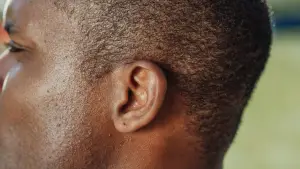Ear infections are a common health issue that most people experience at some point in their lives—especially during childhood. For many, they’re a temporary discomfort treated with rest or antibiotics. But what happens when an ear infection lingers or recurs frequently? Can something as routine as an ear infection cause lasting damage?
The answer is yes—in some cases, ear infections can lead to long-term or even permanent hearing loss, particularly if left untreated or if they recur over time. This risk is especially important to understand for older adults, caregivers, and those with existing ear or sinus problems.
This article will explore how different types of ear infections can impact your hearing, what symptoms to watch for, and how to prevent short-term issues from turning into long-term hearing problems. Whether you’re recovering from an infection or caring for someone who is, this guide will help you better understand the connection between ear health and hearing loss—and how to protect both.
Understanding Ear Infections: Types and Causes
To understand how ear infections can affect hearing, it helps to know a bit about ear anatomy and the different types of infections that can occur. The ear is made up of three main parts—outer, middle, and inner ear—and each plays a vital role in hearing. Infections can occur in any of these areas and may impact hearing in different ways.
1. Outer Ear Infections (Otitis Externa)
Often called “swimmer’s ear,” otitis externa is an infection of the ear canal. It usually develops from water remaining in the ear after swimming, creating a moist environment that encourages bacterial growth.
- Common causes: Water exposure, use of ear buds or hearing aids, skin conditions (like eczema)
- Symptoms: Pain, itching, discharge, muffled hearing
- Hearing impact: Typically mild and temporary, unless the infection spreads or recurs frequently
2. Middle Ear Infections (Otitis Media)
This is the most common type, especially in children, but it also affects adults. Otitis media occurs when fluid and infection build up behind the eardrum, often due to colds, sinus infections, or allergies.
- Common causes: Upper respiratory infections, seasonal allergies, Eustachian tube dysfunction
- Symptoms: Ear pain, pressure, fever, fluid drainage, temporary hearing loss
- Hearing impact: Can cause conductive hearing loss, especially if fluid buildup persists or infections become chronic
3. Inner Ear Infections (Labyrinthitis or Vestibular Neuritis)
Less common but potentially more serious, these infections affect the inner ear’s balance and hearing structures. They are often viral and may follow a respiratory illness.
- Common causes: Viral infections (e.g., cold or flu viruses), in rare cases bacterial infections
- Symptoms: Dizziness, nausea, balance problems, ringing in the ears, hearing loss
- Hearing impact: May result in sensorineural hearing loss, which can be permanent if not treated promptly
Understanding these types of ear infections—and their causes—can help you better recognize the early signs and risks. The sooner an infection is diagnosed and treated, the lower the risk of long-term complications, including hearing damage.
How Ear Infections Affect Hearing
Ear infections can disrupt hearing in several ways, depending on the location and severity of the infection. While many cases cause temporary hearing loss, repeated or untreated infections can lead to more permanent damage over time. Understanding how infections affect the auditory system can help you recognize issues early and seek appropriate care.
1. Fluid Buildup in the Middle Ear
One of the most common causes of hearing problems during an ear infection—especially otitis media—is the accumulation of fluid behind the eardrum. This fluid prevents sound waves from being transmitted effectively to the inner ear.
- Impact: Muffled or “blocked” hearing, often described as feeling like listening under water
- Usually temporary, but if fluid remains for weeks or months (as in chronic otitis media with effusion), it can delay auditory development in children and cause persistent hearing issues in adults
2. Eardrum Damage
The pressure from fluid buildup can sometimes cause the eardrum to bulge or rupture. While eardrums usually heal on their own, repeated ruptures or infections can lead to scarring (tympanosclerosis), which can stiffen the eardrum and reduce its ability to vibrate properly.
- Impact: Reduced hearing clarity or sensitivity
- Permanent damage may occur if the eardrum doesn’t heal correctly or becomes thickened from repeated trauma
3. Damage to the Ossicles (Middle Ear Bones)
Severe or long-standing infections can affect the tiny bones in the middle ear—the malleus, incus, and stapes—that are essential for transmitting sound.
- Impact: Conductive hearing loss that may require surgical repair
- While rare, chronic infections like cholesteatoma (an abnormal skin growth in the middle ear) can erode these bones
4. Involvement of the Inner Ear
In some cases, particularly with viral inner ear infections (labyrinthitis), the infection can affect the cochlea or auditory nerve, resulting in sensorineural hearing loss.
- Impact: Sudden, sometimes permanent hearing loss, often in one ear
- May also cause tinnitus (ringing in the ear) and balance issues
5. Inflammatory and Immune Response
Chronic infections can trigger long-term inflammation, which can damage sensitive ear tissues. In children, this may lead to developmental delays in speech and language. In adults, it can worsen existing hearing problems or make hearing aids less effective.
Even if hearing loss from an infection seems mild or goes away on its own, it’s important to monitor for changes—especially if infections recur. The cumulative impact of multiple infections over time can significantly increase the risk of long-term damage.
When Temporary Hearing Loss Becomes Permanent
Most hearing loss from ear infections is temporary, especially when infections are treated early and properly. However, there are cases—particularly with recurrent, untreated, or severe infections—where the damage becomes permanent. Understanding when and how this transition happens is key to preserving long-term hearing health.
Types of Hearing Loss from Ear Infections
There are two main categories of hearing loss caused by infections:
- Conductive Hearing Loss: Caused by blockages or damage in the outer or middle ear (e.g., fluid buildup, ruptured eardrum, ossicle damage). This type is often temporary but can become permanent if chronic or untreated.
- Sensorineural Hearing Loss: Results from damage to the inner ear (cochlea) or auditory nerve. This type is usually permanent and more difficult to treat with conventional medical therapies.
Infections may start as conductive issues but progress into sensorineural damage if they spread deeper or are not resolved quickly.
When Temporary Becomes Permanent
The shift from temporary to permanent hearing loss can occur in several scenarios:
- Chronic Otitis Media with Effusion: Fluid remains in the middle ear for more than 3 months. This can lead to structural changes, thickening of the eardrum, or erosion of the ossicles.
- Recurrent Infections: Repeated bouts of otitis media or externa may cause scarring, eardrum perforation, or damage to the hearing bones.
- Inner Ear Involvement: Viral or bacterial infections that spread to the cochlea can irreversibly damage the tiny hair cells responsible for sound transmission.
- Delayed or Inadequate Treatment: If an infection isn’t treated in time—or if antibiotics are not fully effective—the risk of lasting complications increases, especially in immunocompromised individuals or older adults.
- Complications Like Cholesteatoma: This abnormal growth in the middle ear, often resulting from chronic infections, can erode structures and lead to persistent hearing loss if not surgically removed.
Recognizing the Risk Factors
You may be more at risk for permanent hearing loss from infections if:
- You’ve had multiple ear infections in a year
- Infections are left untreated or return frequently
- You experience a ruptured eardrum more than once
- You’re already managing age-related hearing loss
- You have underlying conditions affecting immunity or sinus function
If you’ve had frequent or prolonged ear infections, it’s important to consult an audiologist or ENT specialist. Early intervention—such as hearing tests, imaging, or even surgery—can prevent irreversible damage and preserve your hearing for the future.
Warning Signs and When to Seek Help
Recognizing the early symptoms of an ear infection—and understanding when they may signal something more serious—is essential for protecting your hearing. While some infections resolve on their own, others require prompt medical treatment to prevent complications, including permanent hearing loss.
Common Signs of an Ear Infection
For adults, the symptoms of an ear infection may include:
- Ear pain or a feeling of pressure/fullness
- Muffled hearing or temporary hearing loss
- Drainage from the ear (clear, yellow, or bloody fluid)
- A sensation of fluid moving or crackling in the ear
- Dizziness or balance issues
- Fever or general discomfort (less common in adults)
Children may also experience:
- Tugging or pulling at the ear
- Crying more than usual or irritability
- Trouble sleeping
- Loss of appetite
Signs That the Infection Might Be Affecting Hearing Permanently
If you or someone you care for experiences any of the following, it’s important to seek medical attention promptly:
- Sudden or severe hearing loss in one or both ears
- Ongoing fluid drainage from the ear lasting more than a few days
- Persistent muffled hearing even after the pain or infection resolves
- Recurring ear infections (3 or more in 6 months)
- Tinnitus (ringing or buzzing in the ear) or vertigo
- Ruptured eardrum (sudden sharp pain followed by fluid leakage and hearing loss)
When to See a Healthcare Provider
You should consult a doctor or audiologist if:
- Symptoms persist beyond 48–72 hours
- You notice changes in hearing after an infection
- Over-the-counter pain relievers or home remedies aren’t effective
- The infection returns shortly after treatment
- You have a history of hearing problems or prior ear surgeries
Early diagnosis can make all the difference. A provider may use an otoscope to check for signs of infection or fluid buildup, conduct hearing tests, and recommend imaging or referral to an ENT (ear, nose, and throat) specialist if needed.
Don’t Ignore Subtle Changes
It’s easy to write off mild hearing changes as “just congestion” or “getting older,” but ignoring symptoms increases the risk of permanent damage. Being proactive about your ear health—especially if you’re over 50 or have a history of infections—can help you preserve your hearing for years to come.
Preventing Long-Term Damage from Ear Infections
While not all ear infections can be avoided, many of the factors that lead to complications—like chronic infections or hearing loss—can be minimized with the right precautions. By focusing on prevention and early treatment, you can significantly reduce your risk of long-term hearing damage.
1. Treat Colds and Sinus Infections Promptly
Many middle ear infections begin with upper respiratory illnesses. When nasal passages become congested, the Eustachian tubes (which drain fluid from the middle ear) can become blocked, leading to fluid buildup and infection.
- What to do: Use decongestants (if recommended), stay hydrated, and treat colds early to prevent spread to the ears.
2. Keep Ears Dry and Clean
Moist environments in the ear canal can encourage bacterial or fungal growth, especially in swimmers or hearing aid users.
- Tips: Dry your ears thoroughly after bathing or swimming, use swimmer’s ear drops if prone to infections, and avoid inserting objects (like cotton swabs) into the ear.
3. Manage Allergies
Seasonal or chronic allergies can contribute to ear infections by causing inflammation and fluid retention in the middle ear.
- What to do: Work with a doctor to manage allergy symptoms and reduce inflammation that might block the Eustachian tubes.
4. Stay Up to Date on Vaccinations
Certain vaccines can help prevent infections that may lead to ear issues.
- Recommended:
- Pneumococcal vaccine (helps prevent pneumonia and related ear infections)
- Flu vaccine (reduces the risk of viral infections that can spread to the ears)
- COVID-19 vaccine (as viral infections have been linked to ear and hearing complications)
5. Don’t Delay Treatment
If you suspect an ear infection—especially with hearing changes—see a provider promptly. Early treatment with antibiotics or other medications can often prevent damage to the ear structures.
- Follow up: After treatment, schedule a follow-up to ensure the infection has cleared completely and fluid hasn’t lingered.
6. Consider Ear Tubes for Chronic Cases
For those with frequent infections or fluid retention, especially children, ear tubes may be recommended to help ventilate the middle ear and prevent pressure buildup.
- Benefits: Reduce the frequency of infections and lower the risk of hearing loss from persistent fluid.
7. Monitor Your Hearing Health
If you’ve had multiple ear infections, consider periodic hearing tests. Audiologists can detect early signs of hearing loss and recommend treatment or hearing aids if necessary.
Prevention is always preferable to treatment when it comes to hearing loss. With awareness and timely care, most people can avoid the long-term effects of ear infections and maintain healthy hearing well into the future.
Conclusion
Ear infections are more than just a temporary annoyance—they can have lasting consequences if not properly managed. While most infections resolve without long-term effects, recurring or untreated infections can damage delicate structures in the ear, potentially leading to permanent hearing loss.
By understanding the types and causes of ear infections, recognizing early warning signs, and seeking prompt treatment, you can significantly reduce your risk. And with preventive strategies—like managing colds and allergies, keeping ears clean and dry, and staying up to date on vaccinations—you can help protect your hearing for years to come.
Whether you’re someone who frequently deals with ear infections, a caregiver for an older adult or child, or simply proactive about your hearing health, staying informed is your first line of defense. Hearing is vital to how we connect with others and navigate the world—don’t let preventable damage from ear infections take that away.
FAQ
Can a single ear infection cause permanent hearing loss?
Most ear infections cause only temporary hearing issues. However, a particularly severe or untreated infection—especially one involving the inner ear or a ruptured eardrum—can lead to lasting damage. Prompt treatment helps reduce this risk significantly.
How can I tell if my hearing loss is from an ear infection or something else?
If hearing loss occurs suddenly during or after symptoms like ear pain, fluid drainage, or a respiratory illness, it’s likely related to an ear infection. A hearing test and ear exam by an audiologist or ENT can determine the exact cause.
Is hearing loss from ear infections reversible?
In many cases, yes. Temporary hearing loss caused by fluid buildup or inflammation often resolves with treatment. However, if infections are frequent or involve damage to the inner ear or auditory nerve, the hearing loss may become permanent.
Are ear infections more dangerous for older adults?
Yes, older adults may experience slower healing, have underlying conditions that complicate infections, or already be experiencing age-related hearing loss. This combination can increase the risk of complications, including permanent hearing damage.
What should I do if I get frequent ear infections?
See an ENT specialist for evaluation. They may recommend imaging, hearing tests, or treatments like ear tubes, allergy management, or preventive medications to reduce the frequency and severity of infections.
“This article is for informational purposes only and is not a substitute for professional medical advice, diagnosis, or treatment. If you are concerned about your hearing or ear health, please consult a qualified healthcare provider.”






